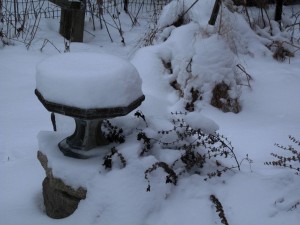It’s not hard to garden or think about gardening (or write or talk about gardening) during the ‘active’ seasons of spring, summer, and fall. Every time you step outside, you are surrounded by growing things calling for your attention. You can easily get caught up in the excitement and wear the mantle of “gardener” with no problems.
Then, as happened yesterday here in the Midwest, the snow flies, and soon the ground will freeze. Plants disappear as do seeds and tools and time spent in the dirt. That’s the signal that the outdoor gardening season has come to a close. The earth and the gardener take a much needed break.
These months of rest can still be productive for the gardener. Here are 3 things to do during the “off season” that will result in a better garden and a better gardener come spring.
Reflection— This theme emerges often at the 20minutegarden because we believe it’s so important to take time to evaluate and appreciate what work has been done before moving on. Make a point to celebrate the successes of this season’s gardens. Rather than thinking about the “should have done’s”, let yourself feel good about what you did do. There’s always more possibilities than we can follow up on, yet we need to remember this season’s high points. What grew beyond expectations? What were you most pleased with or surprised about? What pruning or mulching technique yielded good results?
And write those triumphs down! Notes about the past gardening season are so important. We might think we’ll remember later on the lessons learned, but the time goes quickly and it’s ever-increasingly hard to keep track. A gardening notebook (or blog!) is some assurance that you’re keeping track.
Organization — Take some time to organize your notes and gardening plot maps. Put them someplace safe, perhaps a file, and label them. What if you didn’t make notes or maps? See above; it’s not too late to do so now.
Winter is also a great time to organize seeds. Check now to see what is left over, what’s too old (see list), and what you’ll be able to use in the coming year. Store seeds in dry, cool places. Put whole seed packages in glass jars or ziploc bags. Store them in the refrigerator, freezer, or basement or garage, if those places are safe from critters. Label and date them for ease of use.
Preparation Before you know it, seed catalogs will be landing in your mailbox to help you prepare for next year’s garden. If you’ve taken the time to organize your leftover seeds, you’ll be less likely to be seduced into getting carried away with buying too many new ones. Likewise, now is the time to make a garden plan, be it a list or a map of possibilities.
Winter is also a great time to prepare by looking after your tools. If you aren’t in the habit of cleaning tools regularly or oiling wooden handles, why not start.
These practices aren’t substitutions for growing things, but they are great things to do in the cold months to keep the gardening flame glowing. Making time for reflection, organization and preparation will help a gardener get off to a strong start come spring.




One Response
Stay in touch with the conversation, subscribe to the RSS feed for comments on this post.
Continuing the Discussion